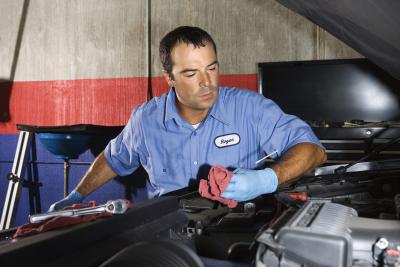
Turbos make a diesel engine run better by design. Today, The Ford Motor Company installs a turbocharger on a Ford Powerstroke diesel engine on every F-Series diesel truck for better torque and horsepower. Believe it or not, Ford’s Powerstroke diesel engines were once manufactured and sold without turbos. Install a turbocharger on a Ford Powerstroke diesel engine to get all the performance and turbo power that late model Powerstrokes enjoy right off the factory floor.
Cut the exhaust pipe 6 inches after the “Y” pipe meets up with the single exhaust pipe under the passenger compartment of the truck. Loosen and remove the four nuts that hold the exhaust flange together. Pull the “Y” pipe free from each of the exhaust manifolds. Dispose of or recycle the old “Y” pipe.
Look inside the engine bay above the transmission housing at the back of the engine on the passenger's side of the truck. There is a lip of metal that runs around the transmission housing and makes up a junction of two pieces of the firewall. Pound the lip flat so that the turbo down pipe can be connected to the exhaust port of the turbo housing and sent back down to connect the new turbo to the old exhaust system.
Install the exhaust manifold up pipe that the turbo mounts to up through the space created by the flattening of the sheet metal lip on the passenger's side of the transmission. At the base of the up pipe is a flange that will connect directly to the passenger's side exhaust manifold. Secure this flange loosely with two flange bolts and two flange bolt nuts. The up pipe should be secure enough to secure the turbo housing to it, but not so tight that no adjustment can be made.
Attach the turbo housing to the top of the turbo up pipe securely. Make adjustments to the alignment by tightening and loosening the flange bolts at the base of the turbo up pipe. Insert the exhaust down pipe up through the remaining space provided by flattening the metal lip of the firewall. Some work may need to be done to the transmission housing to allow the down pipe into the space. Cut off any tabs that can be removed from the edges of the transmission housing to allow for the down pipe to be installed.
Connect an oil feed line to the turbo so that the turbo compressor wheel is appropriately lubricated during use. Use the factory oil sending unit attached to the turbo housing to draw oil up from the bottom of the oil pan. Drill and tap a feed line into the side of the oil pan and run a line back up to the turbo, being careful not to run the new oil line too close to heat sources such as the exhaust, engine, or turbo itself. Install an oil drain line back into the top of the engine's intake manifold using an existing plug as the place to insert a grommet to hold the drain tube
Connect the driver's side exhaust manifold to the new turbo up pipe just below the junction of the turbo up pipe and passenger's side exhaust manifold. Finish by connecting the turbo down pipe to the existing exhaust system and then covering the air intake of the turbo with a high flow air filter. The new turbo is ready for use.